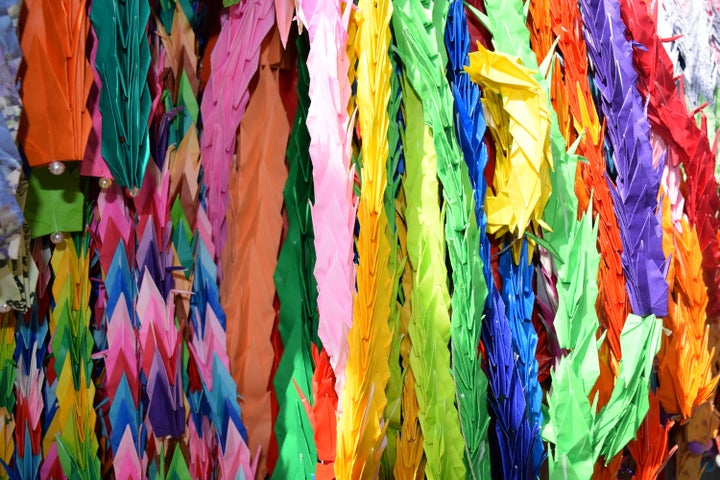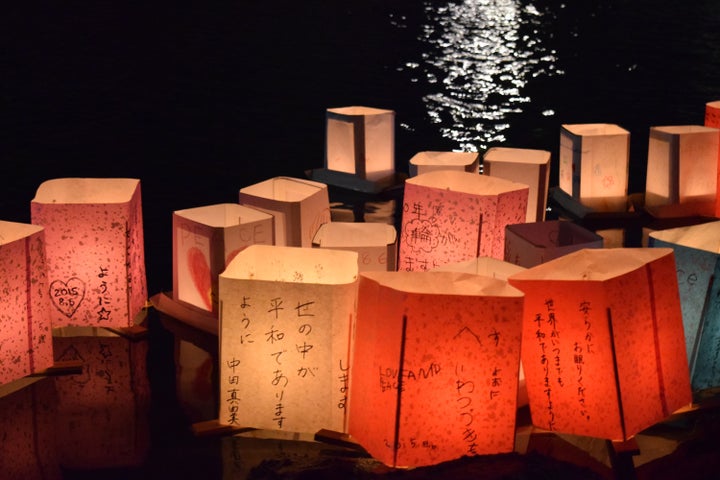
Inside the dimly lit exhibit halls of the Hiroshima Peace Memorial Museum amidst piles of rubble stand wax figures of burnt human beings with skin melting off their arms. Waxy keloid scars lie imprisoned in glass cases along the walls like flesh-colored leeches. Many displays contain singed children’s uniforms, each belonging to one of the roughly 1,400 primary school students who perished on August 6, 1945.
At 8:15 am that day, an American B-29 bomber dropped an atomic bomb on the city of Hiroshima. The warhead exploded with a force equivalent to 15 kilotons of TNT, creating surface temperatures at the hypocenter that rivaled the sun. Approximately 80,000 people—30 percent of the city’s population—died from the blast and subsequent firestorm. Roughly 60,000 more would die from bomb-related health complications.
Today, a message of peace is ubiquitous throughout Hiroshima. In the center of the city lies Peace Memorial Park. To honor the dead, visitors leave behind long strands of origami paper cranes, which workers bind together in vibrant bushels. In the middle of the park stands a saddle-shaped concrete cenotaph. Gazing through its parabolic opening, you can see the skeletal structure of the A-Bomb dome, one of the only buildings to have survived the blast. Directly behind the cenotaph flickers an eternal flame, the peace flame, which will only be extinguished on the day when the last nuclear weapon has been destroyed.
Experts estimate that there are more than 15,000 nuclear weapons in the world today—thousands of potential Hiroshimas and Nagasakis enclosed in fortified facilities and crisscrossing the globe in the bays of nuclear submarines. But discussions over strategic arms reduction have reached an impasse. And instead of reducing their arsenals, the nine nuclear powers have modernized, and in some cases, even augmented their existing stockpiles. In the face of frustrating paralysis, some experts and activists are turning to the symbolic potential of Hiroshima. They hope that bringing people to the city might infuse theoretical discussions with human urgency.
“The basic danger of nuclear weapons is on the humanitarian impact, and Hiroshima and Nagasaki are the only two places where you can actually feel it, so the venue or place is very important,” explained Hidehiko Yuzaki, the governor of Hiroshima prefecture.
Yuzaki has tried to raise Hiroshima’s international profile, encouraging “peace-tourism” and building a large space to attract conferences and summits to Hiroshima’s peace memorial park. Each year, Yuzaki hosts a group of international diplomats, academics and policy makers as part of the “Hiroshima for Global Peace Plan.” By mixing the historical message of survivors with detailed and pragmatic policy proposals, the governor hopes to spur the global community to confront nuclear weapons.
By all objective measures, these efforts have been remarkably successful. In the past five years, Hiroshima has become one of Japan’s most popular destinations for both tourists and international dignitaries. Most recently, Hiroshima hosted the 2016 G7 Foreign Minister’s summit, which brought U.S. Secretary of State John Kerry to the city for the first time. A few months later, in May 2016, President Barack Obama made history as the first sitting U.S. President to visit the city, where he delivered a powerful speech calling for the elimination of nuclear weapons.
The symbolism of an American president standing in Hiroshima to advocate for the abolition of nuclear weapons is staggering, yet for all this success, Hiroshima has also encountered entrenched resistance to its message. In positioning itself as a global peace hub, Hiroshima must reckon with Japan’s history and current political climate—forces that may be at odds with the city’s message.
***

Memory lies at the heart of Hiroshima’s pacifism, but it also creates a political minefield. In 1945, Hiroshima was part of the military-industrial complex of a country waging a brutal war alongside Nazi Germany. For Americans and East Asians in particular, the legacy of Japanese atrocities continues to occupy an important place in diplomatic relations. Across the world, many believe that the atomic bombings of Hiroshima and Nagasaki were an unfortunate, but necessary measure to end the war and save thousands of lives.
“The mission of Hiroshima is at once universalist and yet extremely specific to the experience of Japanese civilians,” explained Kiichi Fujiwara, a professor of Law and Politics at Tokyo University. This reality is especially difficult for Japan’s neighbors, those who directly suffered the injustices of Japanese militarism: murder, rape, torture and destruction. Chinese international leaders have repeatedly criticized the Japanese for using Hiroshima as a means of rewriting history, casting victimizers as victims.
In the mid-1990’s, the Hiroshima Peace Memorial Museum changed its exhibit to include details about Japanese wartime atrocities. But Hiroshima alone cannot counter the perception that Japan has whitewashed its wartime legacy. The experiences of both Hiroshima and Nagasaki may be unique, but the world responds to these cities in the context of Japanese history and politics. And Hiroshima’s rising international profile comes at a time in which many believe Japanese leadership is charting a more militaristic course.
Since the end of WWII, the Japanese public and government have asserted that Japan is a pacifist state. The Japanese constitution contains a “Peace Clause,” outlawing war as a means for settling international disputes. In 1971, the National Diet—Japan’s bicameral legislature —formally adopted Japan’s three non-nuclear principles, which state that Japan will not possess, produce, or allow others to bring nuclear weapons into the country: the only country to have experienced a nuclear attack vowed never acquire a nuke of its own.
But the reality behind this rhetoric is more complicated. After World War II, Japan constructed its security apparatus around the promise of protection under the American nuclear umbrella. Decreases in American involvement in East Asian security have eroded confidence about just how far the U.S. security guarantee truly extends, testing Japan’s rhetorical commitment to pacifism.
“Japan is in a somewhat unusual position because the anti-nuclear feelings are very strong, and yet the desire to maintain a credible extended deterrent from the United States is also strong,” explained Scott Sagan, a nuclear weapons expert at Stanford University. This paradox results in competing interests: support for the principle of nuclear abolition on the one hand, and a vested interest in American nuclear supremacy on the other.
Facing uncertainty about America’s pledge to uphold extended deterrence and pressured by the dual threats of an increasingly aggressive nuclear China and an erratic nuclear North Korea, Prime Minister Shinzo Abe has shifted the tone of Japanese policy.
While Abe’s government maintains the rhetoric of pacifism, his policies have undermined Japan’s historic commitment to peace. Abe was a key driver of the reinterpretation of the “Peace Clause,” and initiated the first significant military buildup since WWII. In the fall of 2015, the upper chamber of the Japanese Parliament passed highly contested bills that authorize Japan to participate in “collective self defense,” meaning that the country could fight alongside a threatened ally even if the country itself is not under attack. And in April 2016, officials in Abe’s cabinet asserted that the Japanese constitution does not prohibit the country from acquiring nuclear weapons — a statement shocking to everyone, except perhaps Donald Trump.
Abe insists that these changes allow Japan to play a more active role in its own security without abandoning its pacifist commitments; however, these decisions have sparked uneasiness both within the region and in the country itself.
Despite the obvious tension, city and prefectural officials in Hiroshima tread carefully around the question of how their mission fits with the Japanese government’s current policies.
“It’s easy to criticize leaders, but it is more important to encourage and give them a better chance of leading, so that is our approach,” suggested Yasuyoshi Komizo, the Chairperson of the Hiroshima Peace Culture Foundation. Komizo and other officials are also quick to point out that the Japanese public overwhelmingly supports spreading the peaceful message of Hiroshima. According to an August 2015 poll, only 11 percent of the Japanese population supports Abe’s reinterpretation of the constitution, and thousands of people marched in Tokyo to protest the government’s new policies.
Although the Japanese public supports pacifism, the policies of the Abe government threaten to undermine Hiroshima’s call for nuclear disarmament. If the city’s message is not reflected in the actions of its own country’s leadership, why should other world leaders listen?
***

Keiko Ogura, a small Japanese woman with cropped black hair, trots down the hallway of the Hiroshima Peace Memorial Museum in bronze heels with an agility that belies her age. Keiko was only eight years old when her world was upended in a flash of light. When she regained consciousness, the first thing she noticed was the flatness. The buildings that had once dotted the horizon were gone, as if a giant hammer had descended from the sky.
An eerie parade of waifs emerged from the wreckage, streaming past Keiko towards the first aid station located in the Shinto shrine on a nearby hill. “Clothes were tattered and shrunk or hanging down, and their skin… their skin was peeling off, just peeling off and showing red wet flesh,” she remembered. They weren’t saying a word. So quietly they were coming, more and more.”
Seventy-one years later, Keiko is a fixture at the Hiroshima Peace Memorial museum, one of the hibakusha—the survivors of the atomic bombing—who have helped guide the post-war identity of the city that gave birth to the nuclear age.
When Keiko visited the United States 12 years ago, she dissolved into tears in the Smithsonian, transfixed with terror at the sight of static B-29 bombers suspended from the ceiling of the Air and Space museum. But she makes it clear that it is not the Americans she blames. Keiko considers war—especially nuclear war—to be an unacceptable evil. It is this universal and unequivocal message that she and many other hibakusha hope to communicate by repeatedly reliving a horror beyond most of our imaginations.
Today, the average hibakusha is over 80 years old. Soon there will be no more survivors to tell their stories. For seventy-one years, Hiroshima’s call for peace and nuclear disarmament has been simultaneously embraced and undermined by the actions of Japanese leadership. And at a moment when the appeal is perhaps more important than ever, Hiroshima finds itself at ideological odds with the Japanese government.
Nuclear weapons are often described as an “existential threat,” but beneath the A-Bomb Dome, that threat casts a concrete shadow. It is this solidity that Keiko and others hope might spur change.
In 1987, recently deceased Holocaust survivor and Nobel Peace Prize recipient Elie Wiesel made a trip to Hiroshima. At the end of his visit, he penned a few lines in the Hiroshima Peace Memorial Museum guest book: “We shall remember. We must remember. For only in memory is there some hope for us all.”
